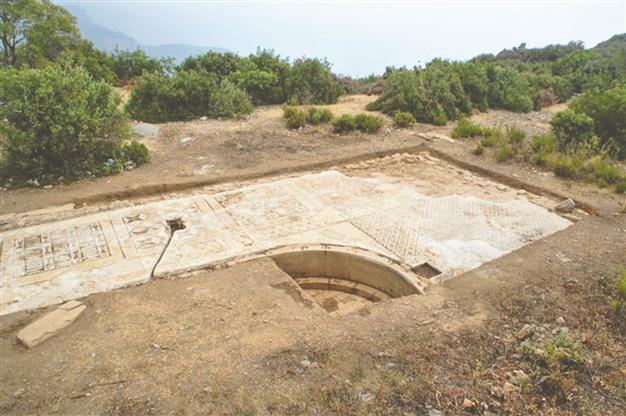Enormous mosaic unearthed in a field
ALANYA

The mosaic, which once decorated the floor of a bath complex, abuts a seven-meter-long pool, which would have been open to the air, according to officials.
A giant poolside mosaic featuring intricate geometric patterns has been unearthed in the southern province of Antalya’s Alanya district, revealing just how far reaching the Roman Empire’s influence was during its peak, Yahoo news reported.The mosaic, which once decorated the floor of a bath complex, abuts a seven-meter-long pool, which would have been open to the air, said Michael Hoff, a University of Nebraska, Lincoln art historian and director of the mosaic excavation. The find likely dates to the third or fourth century, Hoff said. The mosaic itself is an astonishing 149 square meters. “To be honest, I was completely bowled over that the mosaic is that big,” Hoff told LiveScience.
No funds for excavation
The first hint that something stunning lay underground in southern Turkey came in 2002, when Purdue University classics Prof. Nick Rauh walked through a freshly-plowed farmer’s field near the ancient city of Antiochia ad Cragum. The plow had churned up bits of mosaic tile, Hoff said. Rauh consulted other archaeologists. The museum did not have the funds needed to excavate more than a sliver of the mosaic, so archaeologists left the site alone.
Last year, with a new archaeological permit for the site in hand, museum archaeologists invited Hoff and his team to complete the dig.
So far, researchers have uncovered about 40 percent of the mosaic. The floor is in “pristine” condition, Hoff said. It would have fronted an open-air marble swimming pool flanked by porticos.
It is the largest Roman mosaic ever found in southern Turkey, which was thought to be rather peripheral to the Roman Empire, according to Hoff. The existence of the mosaic suggests that Antiochia ad Cragum was far more influenced by the Romans than first believed, Hoff said.
The team will return with students and volunteers to complete the mosaic excavations in June 2013. Hoff said that the plan is to construct a wooden shelter over the entire mosaic and open the site to public visits.
















